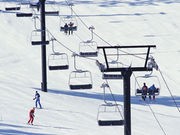

Many families and outdoor enthusiasts hit the slopes this time of year. Skiing and snowboarding are fun for people of all ages, but you need to know how to keep yourself and others safe on crowded mountains, according to Nemours Health.
Having the right clothes and equipment can protect skiers and snowboarders from low temperatures and injuries. In addition to warm clothing, proper boots, poles, goggles and a helmet specifically designed for skiing or snowboarding are essential.
Every time you head up a mountain, this is what you need:
- Skis: Larger skis are typically harder to control. Buy or rent skis that are the appropriate size for your height and skiing ability. Have your skis fitted and tuned by a trained professional.
- Bindings: Bindings hold your boots to your skis or snowboard. They should be able to release if you fall to prevent serious injuries. Bindings that release too easily, however, can also be dangerous. Have your bindings adjusted by a pro.
- Boots: Make sure your boots fit correctly. Your feet should always be comfortable and warm. This will help you control your skis or snowboard. Boots should always be buckled securely to properly support your feet and ankles.
- Poles: Skiers should make sure their poles are the right length and have looped straps that go around wrists.
- Helmet: Wearing a helmet every time you ski or snowboard is the most important way to prevent a life-threatening injury. Be sure your helmet fits properly and always fasten the chin strap securely. Ski and snowboarding helmets have special ventilation for warm days and a place to attach goggles. Don’t wear a football or biking helmet for skiing or snowboarding.
- Goggles and sunglasses: The sun’s rays are stronger at the top of a mountain than at sea level. They can also reflect off the white snow, increasing your risk for exposure to harmful UV rays. Sunglasses are the best way to protect your eyes from the sun’s rays, but goggles can protect against the sun as well as cold, snow, tree branches and other hazards.
- Gloves or mittens: It’s important to wear gloves or mittens while skiing and snowboarding. Some gloves also provide a pocket for hand warmers. In very cold conditions, mittens may offer greater warmth than gloves.
More information
The National Ski Areas Association provides more skiing and snowboarding safety tips.
Source: HealthDay
Copyright © 2024 HealthDay. All rights reserved.

Leave a Reply